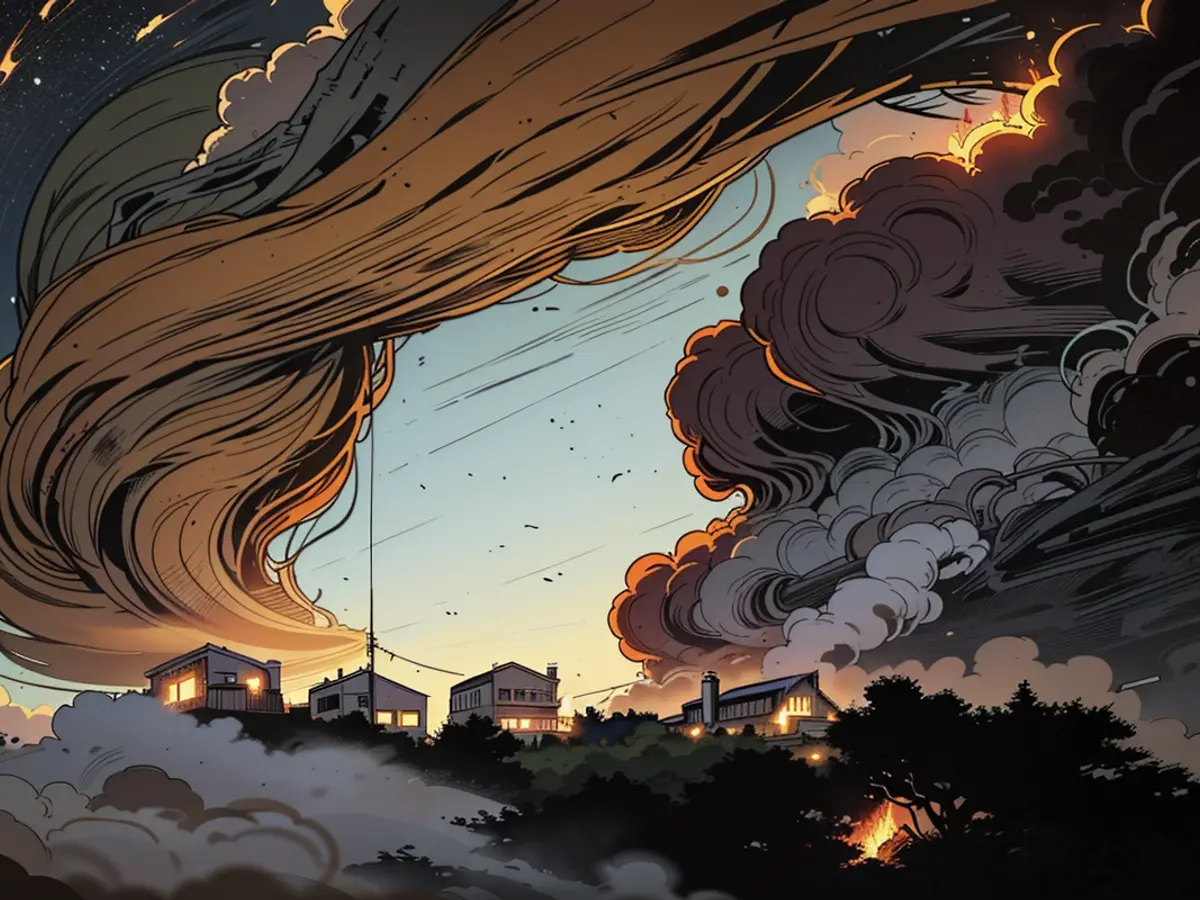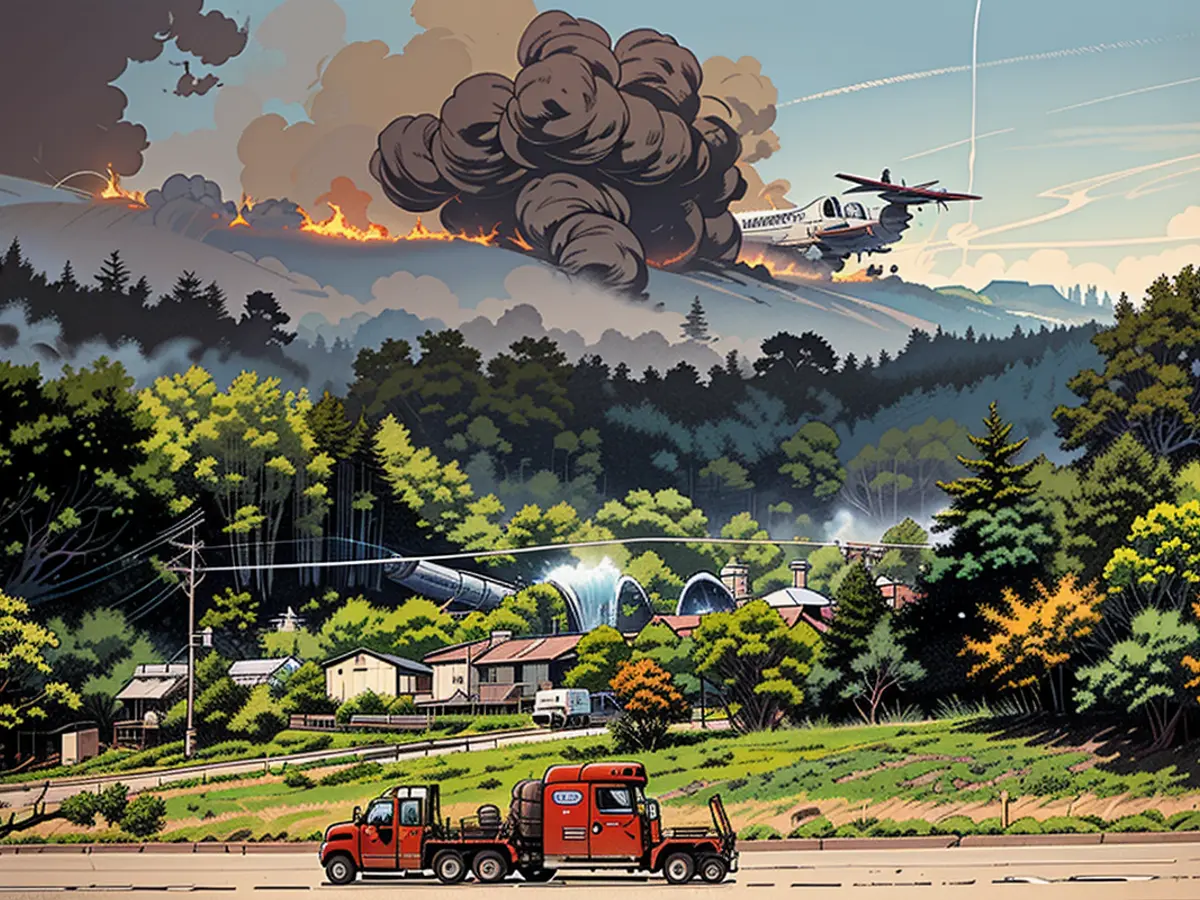Swift-progressing wildfires inflict harm on at least 7 residences in an Oakland area, asserts fire department representative.
No injuries were reported, but Oakland Mayor Sheng Thao stated that at least six homes were damaged, with one being a complete loss.
Oakland Fire Chief Damon Covington revealed that at around 1:30 p.m., emergency calls flooded in regarding a fire situated in front of a property in the Oakland hills. The fire department's arrival was coordinated as the blaze rapidly intensified, with wind speeds varying from gentle zephyrs to 40 mph gusts, under Friday's red flag conditions.
Covington remarked, "The wind was relentless."
The fire threatened the 580 Freeway, which connects the San Francisco Bay Area to central California, resulting in traffic congestion as people attempted to vacate the area and hazy smoke drifted over the city's 440,000-strong population.
The fire ravaged eucalyptus trees, which in turn spread the flames as they hopped over road divides, as Covington explained. Within three hours, the flames had consumed 13 acres of land. By approximately 4 p.m., crews successfully halted the fire's advancement, despite a tireless battle from dozens of firefighters.
The source of the Oakland fire was initially unknown.
Red flag warnings were issued for fire risk until Saturday across a vast swath of the state, from the central coast to the Bay Area, and into northern Shasta County—not far from the Oregon border.
California's energy provider shut off power in 19 counties across the northern and central state as a significant "diablo wind"—notorious during autumn for its hot, dry gusts—heightened the risk of wildfire.
The Oakland Hills blaze occurred a day prior to the Oct. 19 commemoration of a 1991 fire that ravaged nearly 3,000 homes and claimed the lives of 25 individuals.
Friday, smoke was distinguishable from a distance of 2 to 3 miles. Firetrucks and ambulances grappled with the congestion in the freeway’s westbound lanes, their sirens blaring to encourage vehicles to yield as they sped toward the blaze. The gridlock created enough frustration among drivers that they exited the roadway through on-ramps, while others drove on the freeway's shoulder. The side streets remained painfully gridlocked as well.
Red flag warnings were also issued in parts of Southern California where a separate brush fire raged toward homes in the Rolling Heights area of Los Angeles County, according to the Los Angeles County Fire Department.
The fire was reported around 3:00 p.m. in the Hacienda Heights hills, where firefighters both on the ground and in the air were working tirelessly to prevent the 5-acre blaze from reaching neighboring homes, the department stated. No evacuation orders have been issued.
Approximately 16,000 customers lost power on Friday after Pacific Gas and Electric cut power.
During a diablo wind, humidity levels decrease significantly, turning vegetation into tinder that is ready to ignite. The term—“diablo” is Spanish for “devil”—is colloquially applied to a hot wind that blows near the San Francisco region from the interior toward the coast as high pressure builds over the West.
The “diablo wind” is projected to generate sustained winds reaching 35 mph in various areas, with potential gusts of up to 65 mph on mountaintops, according to the National Weather Service. Powerful winds are expected to persist through part of the weekend.
An estimated 20,000 customers could be temporarily without power over the subsequent few days, PG&E said in a statement on Friday.
The National Weather Service issued red flag warnings for the valleys and mountains of Los Angeles County, portions of the Inland Empire, and the San Bernardino Mountains due to Santa Ana winds—dry, warm, and gusty northeast winds that originate from the interior of Southern California and move toward the coast and offshore. The winds operate contrary to the usual onshore flow, which transports moist air from the Pacific into the region.
Winds in the Greater Los Angeles area won't be as intense as up north, with gusts of 25 to 40 mph possible in mountainous and foothill regions, said Mike Wofford, a meteorologist with the Los Angeles-area office of the weather service.
The strongest winds were being recorded in the Santa Monica and San Gabriel mountains, where Friday saw gusts of 45 to 55 mph with isolated gusts of up to 60 mph, he said.
Meanwhile, some mountaintops around Lake Tahoe received a light dusting of snow on Friday, as per the National Weather Service in Reno, Nevada. Low temperatures below freezing are anticipated again Friday night through Saturday.
Wind sensors at two peaks west of Lake Tahoe demonstrated 75 and 104 mph winds on Friday, with strong winds predicted to persist throughout the night before gradually subsiding Saturday morning, as per the National Weather Service.
The service also issued an early freeze warning for the Sierra’s eastern front, effective from 2 a.m. to 9 a.m. Friday, covering regions south of Carson City to the north, including Reno and Lassen, Sierra, and Plumas counties in California, where temperatures could drop into the low 20s Fahrenheit.
The fire threatened to disrupt our usual commute on the 580 Freeway, as it caused traffic congestion and hazy smoke over the city. The Mayor of Oakland, Sheng Thao, mentioned that our community was affected, with at least six homes being damaged, including one that was a complete loss.









